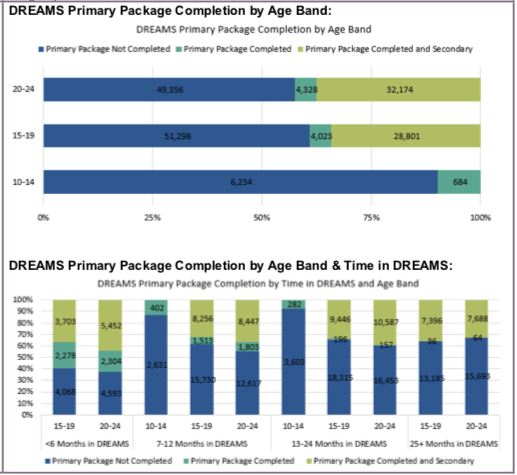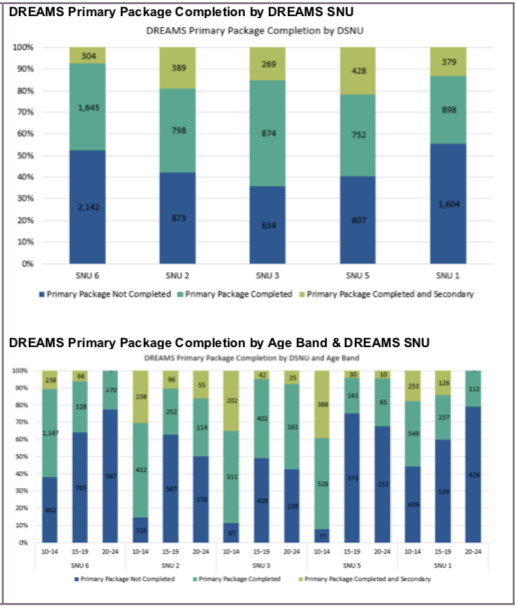(AGYW_PREV) Percentage of adolescent girls and young women (AGYW) that completed at least the DREAMS primary package of evidence-based services/interventions
Export Indicator
This indicator reflects program data on how many AGYW are being served in DREAMS and whether all active DREAMS beneficiaries have received the intended layered services/interventions to ensure that they remain HIV-free. Specifically, this indicator will measure how many active DREAMS beneficiaries have completed the DREAMS primary package of services/interventions, the primary package plus any secondary services/interventions, and how many have not yet completed the primary package. Of note, a DREAMS Beneficiary is when an AGYW is enrolled in DREAMS and has started or completed at least one DREAMS service/intervention.
Who is Captured Under AGYW_PREV:
AGYW should only be counted under AGYW_PREV if they are an active DREAMS beneficiary (see below for definition of active beneficiary). The graphic and definitions below outline the client flow for this indicator in more detail, as aligned with the DREAMS program completion continuum:
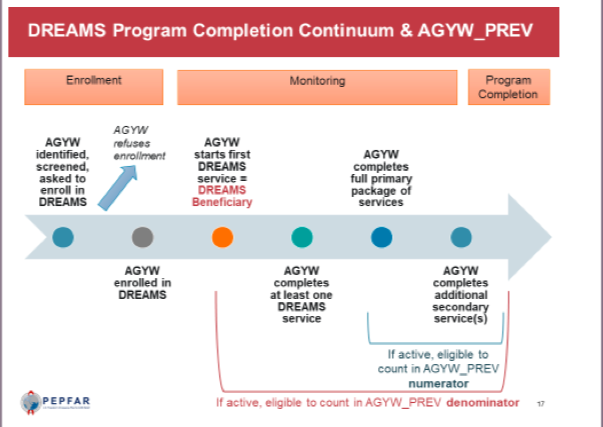
Enrolled: AGYW identified based on country-specific eligibility criteria/assessment for HIV risk and accepts enrollment into the DREAMS program.
While a vulnerability assessment and/or enrollment screening may be a prerequisite to receiving a DREAMS service, the enrollment or screening by itself is not considered a qualifying DREAMS service under this indicator. AGYW and female OVC who are within the 10-24 age band but do not meet DREAMS criteria and have not been enrolled in DREAMS should not be counted in this indicator. They should instead be counted under other MER indicators such as OVC_SERV or PP_PREV as relevant to the definition of these indicators and the services that they receive.
DREAMS Beneficiary: AGYW is enrolled in DREAMS and has started or completed at least one DREAMS service/intervention.
Active DREAMS Beneficiary: AGYW is enrolled in DREAMS and has started or completed at least one DREAMS service/intervention in the past 6 months (at Q2) or 12 months (at Q4). Only active DREAMS beneficiaries are counted under AGYW_PREV.
Inactive DREAMS Beneficiary: AGYW is enrolled in DREAMS and at one time had started or completed at least one DREAMS service/intervention but has not started or completed a service/intervention within the past 6 months (at Q2) or 12 months (at Q4).
Defining the Country-Specific DREAMS Package:
Each country is responsible for designating its own primary package of services/interventions for each DREAMS AGYW age band (10-14, 15-19 and 20-24) based on the DREAMS Guidance. All 15 DREAMS countries will be required to submit a DREAMS Layering Table detailing their primary/secondary/contextual interventions for each age band to OGAC on an annual basis.
- Primary services/interventions are defined as interventions that ALL AGYW in an age group should receive if they are enrolled in DREAMS in an OU.
- Secondary services/interventions are needs-based interventions that are part of an OU’s DREAMS core package but may not be received by all AGYW in that age group (i.e., only AGYW who experience violence should receive post-violence care).
- Contextual interventions are those that are part of an OU’s DREAMS core package but cannot be linked to an individual AGYW (i.e., community mobilization). Note that these interventions should be included in your layering table but are not tracked as part of the AGYW_PREV indicator as, by definition, they are not linked to individual AGYW.
Only services provided by PEPFAR count under AGYW_PREV. However, if PEPFAR implementing partners are making active referrals to a service provided by a non-PEPFAR entity, the active referral may be counted as a DREAMS service under AGYW_PREV. If this is the case, your OU-specific Layering Table should specify this (e.g., “facilitating access to government education subsidies” instead of just “education subsidies”).
DREAMS programs are expected to reach 9-14-year-olds with approved primary prevention of HIV & sexual violence interventions. These interventions should be part of the primary package of interventions for 9-14-year-old active DREAMS beneficiaries and should count towards an active DREAMS beneficiary’s layering status once the service is completed. Completion of the approved primary prevention intervention can also be reported under OVC_SERV in addition to AGYW_PREV (see OVC_SERV guidance). As AGYW_PREV does not include the 5-9 age band, nine-year-olds will not be included in the indicator numerator. Teams should use the AGYW_PREV narrative to report the number of nine- year-olds that are active DREAMS beneficiaries within the reporting period.
Approved primary prevention of sexual violence and HIV interventions are as follows: Families Matter Program, Sinovuyo Teen, Coaching Boys into Men, IMpower, and Stepping Stones. Countries are strongly encouraged to implement one of these five pre-approved curricula. All other curricula used for 9-14 primary prevention must be approved by S/GAC and the relevant agency HQ and must include the three S/GAC evidence-informed modules on healthy and unhealthy relationships, healthy choices about sex, and understanding non- consensual sex.
Counting Service and Package Completion:
Services/interventions should only be counted towards primary package completion if the AGYW has completed that particular service/intervention. Countries should define service/intervention completion as part of their country-specific DREAMS Layering Table. Completion definitions should be based on normative guidance and instructions from program developers where available (e.g., country may count a multi-session intervention as complete after beneficiary has attended 80% of the sessions if that is what the instructions from the program developer indicate as completion). Do not count an intervention towards primary/secondary package completion for an individual AGYW until it has been completed per the country’s service completion definition. Please note that “primary package completion” as tracked in AGYW_PREV and “DREAMS program completion” as defined in the DREAMS Program Completion and Saturation Document are not the same thing. DREAMS program completion requires that an individual AGYW has completed both the primary package for her age group, as well as all secondary interventions that are appropriate based on her needs.
An AGYW must have completed at least one service in the past 6 months at Q2 or the past 12 months at Q4 to be counted in any of the following disaggregates: completed the fully primary package and no additional services, completed the primary package and at least one additional service, or completed at least one service but not the full primary package. At Q2 and Q4 reporting, AGYW should be reported under the disaggregate that reflects the snapshot of her current layering status since beginning the DREAMS program. For example, if an AGYW completed her last service in the primary package in the last 6 months (at Q2) or 12 months (at Q4) then she may be counted in the corresponding numerator disaggregate for the current time period, even if she enrolled and began receiving services in DREAMS beginning in a previous year or reporting period. For AGYW reported in the disaggregate of completed at least one service but not the fully primary package, any DREAMS service (from the primary or secondary package) may be counted.
An AGYW that is enrolled and has started a DREAMS service but has not yet completed it as of the end of the reporting period is still considered an active DREAMS beneficiary (see above). She would be reported in the corresponding disaggregate. If an AGYW has already completed a DREAMS service/intervention while in DREAMS, she should be reported under one the layering disaggregates indicating service completion. For example, if an AGYW has completed HTS but is in process of completing a multi-session prevention curriculum at Q2 (and has not yet completed the primary package), she should be counted in the “completed at least one DREAMS service but not the full primary package” disaggregate.
Using AGYW_PREV Results to Ensure Programmatic Layering:
The focus of this indicator is to track the layering of the country-specific DREAMS primary package of services/interventions, rather than tracking individual services/interventions themselves. Specific services received by AGYW will continue to be counted under PP_PREV, OVC_SERV, HTS_TST, PREP_NEW, PREP_CURR, PMTCT_STAT, GEND_GBV, KP_PREV, etc. as appropriate. Furthermore, AGYW enrolled in DREAMS and receiving DREAMS services should be counted under this indicator regardless of the budget code(s) funding the services that they received. For example, if an AGYW is enrolled in DREAMS and receives HIV testing, education support, and PrEP in the reporting period, she would be counted under HTS_TST, PREP_NEW, PREP_CURR, and OVC_SERV if she meets the definition of each respective indicator. She would also be counted under AGYW_PREV under the appropriate layering and time in DREAMS disaggregates to track if she has received the age-appropriate primary package of DREAMS services/interventions.
AGYW_PREV was not created to measure or show the impact of DREAMS, it was created to monitor fidelity to layering and to assess DREAMS implementation on the ground. DREAMS country teams should review multiple data sources (i.e., ongoing analyses per the DREAMS Program Completion and Saturation Document) along with AGYW_PREV to evaluate overall DREAMS program performance and coverage.
Results from this indicator will be used to ensure that layering of DREAMS services is happening across agencies and partners within DREAMS districts and will be used to make programmatic decisions to ensure comprehensive, patient-centered prevention programming for AGYW. AGYW_PREV results will help field teams and HQ answer several essential questions related to DREAMS programming, quality, and reach, including:
- How many active DREAMS beneficiaries are in the DREAMS program?
- Is layering happening as intended for all AGYW receiving DREAMS services? Are there specific services/interventions that are not reaching AGYW as intended? Are there specific SNUs where layering is stronger or weaker? Are there specific age bands where layering is stronger or weaker?
- How does layering change over the time a girl is enrolled in DREAMS?
- Have 90% of active DREAMS beneficiaries completed at least the primary package after being in DREAMS for 13+ months?
- Where are active DREAMS beneficiaries along the DREAMS program completion continuum?
Number of individual AGYW that have completed at least the DREAMS primary package of services/interventions as of the end of the reporting period
Number of individual AGYW that have started or completed any DREAMS service/intervention as of the end of the reporting period
How to calculate annual total:
This is a snapshot indicator. Results should reflect a snapshot of each AGYW’s layering status since they initially became a DREAMS beneficiary until the end of the Q4 reporting period.
Q4 numerator = Number of AGYW that have fully completed the DREAMS primary package of services/intervention but no additional services as of Q4 + Number of AGYW that have fully completed the DREAMS primary package of services/interventions and at least one secondary service/intervention as of Q4
Q4 denominator = Number of AGYW that have started or completed any DREAMS service within the past 12 months (i.e., the sum of all 4 AGYW_PREV disaggregates).
How to collect:
This indicator should be reported only in SNUs where DREAMS-funded activities are occurring in the 15 DREAMS countries (this includes countries previously referred to as DREAMS-like countries).
This indicator will be inputted in DATIM by the USG team, not individual IPs since this indicator involves data from multiple implementing partners over time. It is recommended that one coordinating partner track layering data within an OU; however, since layering occurs between multiple implementing partners and across time and mechanisms the USG team (DREAMS coordinator or DREAMS POC(s)) is best placed to input the data for AGYW_PREV.
Data collection requires reliable tracking systems that are designed to count the number of one-on-one encounters or participation in group interventions and that reduce double- counting of individuals in a reporting period. A unique identifier should be assigned to AGYW enrolled in DREAMS to track individual-level completion of DREAMS services across partners providing DREAMS services, where applicable. Data should be collected at every encounter/point of service and aggregated in time for PEPFAR reporting cycles.
Examples of successful DREAMS layering data collection include the use of unique IDs, DREAMS passports or ID cards, and DHIS2 databases. It is a best practice to have one implementing partner that is responsible for the coordination of layering data systems; this partner then works across agencies and partners to ensure that all DREAMS services/interventions available to AGYW are captured within the system. Since layering occurs across partners, agencies, and over time, this indicator will be inputted by USG personnel (e.g., DREAMS coordinator or interagency DREAMS POCs).
How to review for data quality:
Data should be reviewed regularly for the purposes of program management, to monitor progress of layering, and to identify and correct any data quality issues. Potential data quality issues for AGYW_PREV:
Numerator is less than or equal to the denominator. The total number of AGYW that have started or completed any DREAMS service in the reporting period must be larger than the number of AGYW that have completed at least the primary package as of the end of the reporting period.
Reporting level: Community (Reported by USG team, not implementing partners)
Reporting frequency: Semi-annually
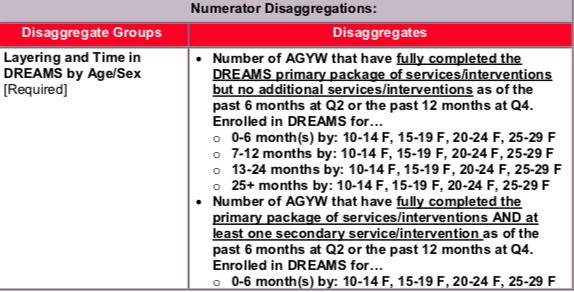
![]()
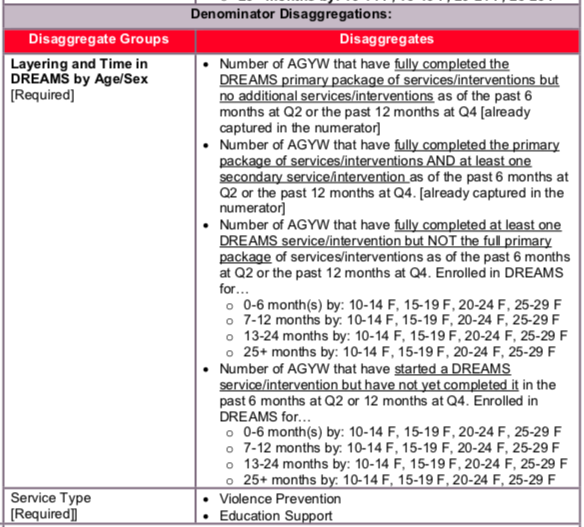
Numerator Disaggregates:
- Age/Sex/Layering/Time disaggregates [required]:
- Age/Sex disaggregate: This should represent the current age of the AGYW at the end of the current reporting period. For example, if a girl is enrolled when she is 14 but turns 15 during the reporting period, she should be reported in the 15-19 age band and receive the corresponding primary services.
- While the DREAMS Layering Table focuses on the DREAMS target age groups of 10-24-year-old AGYW, the 25-29 age band is included here to account for AGYW who have aged over 24 years since initial DREAMS enrollment. DREAMS programming should not target 25-29-year-old AGYW unless explicitly approved in your COP.
- Layering of services/interventions disaggregate: Countries should use their approved DREAMS Layering Tables to determine the makeup of the primary package of services/interventions reported in this indicator. A service should not be counted towards package completion until it is fully completed by the individual AGYW (see above).
- Time in DREAMS disaggregate: Represents the time since each AGYW became a DREAMS beneficiary (i.e., since the AGYW was enrolled and started or completed at least one DREAMS service/intervention).
Denominator Disaggregates:
- Age/Sex/Layering/Time disaggregates [required]:
- Age/Sex disaggregate: This should represent the current age of the AGYW at the end of the current reporting period. For example, if a girl is enrolled when she is 14 but turns 15 during the reporting period, she should be reported in the 15-19 age band and receive the corresponding primary services.
- While the DREAMS Layering Table focuses on the DREAMS target age groups of 10-24-year-old AGYW, the 25-29 age band is included here to account for AGYW who have aged over 24 years since initial DREAMS enrollment. DREAMS programming should not target 25-29-year-old AGYW unless explicitly approved in your COP.
- Layering of services/interventions disaggregate: Countries should use their approved DREAMS Layering Tables to determine the makeup of the primary package of services/interventions reported in this indicator. A service should not be counted towards package completion until it is fully completed by the individual AGYW (see above).
- Time in DREAMS disaggregate: Represents the time since each AGYW became a DREAMS beneficiary (i.e., since the AGYW was enrolled and started or completed at least one DREAMS service/intervention)
- Service disaggregates [required]: Service disaggregates should only be reported for active DREAMS beneficiaries (i.e., AGYW enrolled in DREAMS that have started or completed at least one DREAMS service in the past 6 months at Q2 or past 12 months at Q4). The AGYW’s first service in DREAMS could be a violence prevention intervention or education support.
- Violence Prevention: Report the number of AGYW enrolled in DREAMS that completed an evidence-based intervention focused on preventing violence within the past 6 months (at Q2) or past 12 months (at Q4). Interventions include: combination socioeconomic interventions; curriculum- based programs in schools, sports programs, or other community venues to change knowledge, skills and norms; parenting/caregiver programs that address violence prevention with parents, but also involve the AGYW. AGYW should be counted under this disaggregate only when they have completed the intervention.
- Education Support: Report the number of AGYW enrolled in DREAMS who have received educational support to remain in, advance, and/or rematriculate in school within the past 6 months (at Q2) or past 12 months (at Q4). Interventions include: school block grants, individual bursaries, tuition, school fees, or fee exemption, support for uniforms and scholastic materials.
The numerator is the sum of the following age/sex/layering disaggregates:
- Number of AGYW that have fully completed the DREAMS primary package of services/interventions but no additional services/interventions
- Number of AGYW that have fully completed the DREAMS primary package of services/interventions AND at least one secondary service/intervention
The denominator is the sum of the following age/sex/layering disaggregates:
- Number of AGYW that have fully completed the DREAMS primary package of services/interventions but no additional services/interventions
- Number of AGYW that have fully completed the DREAMS primary package of services/interventions AND at least one secondary service/intervention
- Number of AGYW that have completed at least one DREAMS service/intervention but not the full primary package
- Number of AGYW that have started a DREAMS service/intervention but have not yet completed it
Indicator Changes (MER 2.0 v2.3 to v2.4):
- Reporting period of indicator changed from cumulative to snapshot, reflecting AGYW service completion as of the past 6 months at Q2 and the past 12 months at Q4.
- Reorganization of Numerator and Denominator disaggregates to better align with AGYW_PREV numerator definition.
- Added denominator disaggregate to capture AGYW enrolled in DREAMS that have started but not yet completed a DREAMS service/intervention in the reporting period.
- All disaggregates made mandatory as they are essential to understanding the success and quality of DREAMS programs.
- Clarifying language added to the indicator reference sheet, including: defining enrolled, active, and inactive DREAMS beneficiaries; defining and differentiating between service, package, and DREAMS program completion; using AGYW_PREV data for program improvement; and updated visuals.
- Changes made to guiding narrative questions.
PEPFAR-support definition:
Standard definition of DSD and TA-SDI used.
Provision of key staff or commodities for AGYW receiving HIV prevention services includes: ongoing procurement of critical commodities such as condoms, teaching materials, or community promotion materials; funding for salaries of personnel delivering the individual, small group, or community-level intervention; stipends or incentives for volunteers; or paying for transportation of those staff to the point of Service delivery. Staff responsible for the completeness and quality of routine patient records (paper or electronic) can be counted here; however, staff who exclusively fulfill MOH and donor reporting requirements cannot be counted.
For AGYW receiving HIV prevention, ongoing support services service delivery improvement includes: site supervision; training or assistance with monitoring and evaluation; QI/QC; and development of materials and protocols.
Guiding narrative questions:
Each OU should submit one narrative response, based on input from all agencies and implementing partners.
- Describe your OU’s approach to measuring layering and reporting on this indicator (e.g., unique identifiers, tracking individuals, analysis of coverage in small geographic areas).
- What challenges and/or data quality issues did you face in reporting on AGYW_PREV?
- Describe your OU’s approach to ensuring that partners are layering services and interventions for AGYW enrolled in DREAMS, including ensuring effective referral mechanisms and linkages have been established between clinical and community- based platforms? How have you used the data for this indicator to inform your programming?
- What are the challenges with implementing layering (i.e., AGYW subgroups who have difficulty participating in services/interventions, partners that have trouble with linking to services, etc.)? If there are gaps in DREAMS layering, which particular services (by age group) are the most challenging for AGYW to complete?
- AGYW_PREV only captures active DREAMS beneficiaries. Does your OU have a large number of inactive DREAMS beneficiaries (i.e., AGYW who are enrolled in DREAMS and at one point completed or started a service, but not within the reporting period)? What are the reasons why AGYW are not active in DREAMS? What is being done to reengage these AGYW into the DREAMS program?
- Please report the number of nine-year-olds that are active DREAMS beneficiaries in your OU at the time of reporting (if any)?
General DREAMS narrative questions:
Each OU should submit one narrative response, based on input from all agencies and implementing partners. These questions refer to the DREAMS Program Completion and Saturation Document.
- Describe your process for determining the DREAMS program completion status of each DREAMS beneficiary. How many DREAMS beneficiaries have reached program completion (cumulatively and in the reporting period)? How often are AGYW monitored to record program completion progress?
- Describe your process for determining saturation within each DREAMS SNU. What data sources are you using to estimate the DREAMS saturation denominator for each age group? What is the saturation status of each current DREAMS SNU?
Data Visualization & Use Examples:
